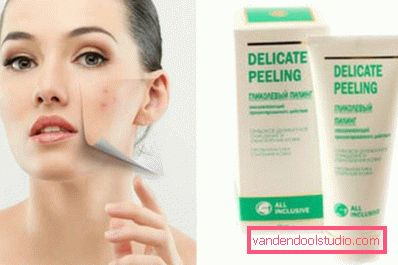Glycolic peeling - return skin beauty

Under the conditions of urban air dustiness, each woman’s skin experiences some stress. Pores are blocked by dust particles and, as a result, oxygen starvation occurs, which disrupts the regenerative processes in the skin and it ages. Also, clogging of the pores leads to increased work of the sebaceous glands, which can additionally close the pores and contribute to the growth of microbes and the appearance of skin lesions. Glycolic peels can help solve many of these problems. Positive feedback on this procedure has made her very popular among women.
What is the essence of glycolic peeling?
Face glycolic peeling is a chemical type of superficial skin cleaning with glycolic (hydroxyacetic) acid that is able to penetrate the upper layers of the dermis and burn old cells. But there is also an impact on living cells, in which the acid increases metabolism, arousing them to life. This is especially important for aging skin, which slows down the renewal process. Therefore, glycolic acid peeling helps to awaken the sleeping cells of the skin of the face. Collagen synthesis is stimulated, skin elasticity increases, fine wrinkles are filled. There is an alignment of the skin texture, normal pigmentation in the presence of freckles and pigment spots.

Indications for glycolic peeling
What problems will chemical glycol peeling help solve?
- Oily skin with dilated pores, as this acid is able to normalize the sebaceous glands.
- Seborrhea - excess sebum production.
- Pigmentation disorders.
- Problem skin (acne, comedones).
- Post-acne scars after inflammation of the face.
- Hyperkeratosis is excessive keratinization of the stratum corneum.
- Dry and flaky skin.
- Small mimic wrinkles.
- Contagious mollusk.
- Preparation for deeper cosmetic procedures - laser and mechanical peeling, as well as plastic surgery.

Contraindications to glycolic peeling
There are a number of contraindications to glycolic peeling:
- Intolerance to the components of the mixture for the procedure.
- Fresh wound processes on the face.
- Inflammatory elements.
- Neoplasms, warts.
- Systemic diseases of the connective tissue.
- Pregnancy and breastfeeding period.
- Herpes.
- Pathologically dilated blood vessels of the face.

Step-by-Step Glycolic Peeling Procedure
Glycolic acid peeling is carried out by a specialist in a cosmetology clinic. At home, there is a high risk of complications after the procedure. It is better to conduct sessions in the autumn-winter period, since ultraviolet rays irritate the renewed skin.
Required test for sensitivity to the peeling mixture. For this mixture is applied to the inner surface of the forearm. Means is maintained 5 minutes and washed off. During the day for the place of application of the drug is under close supervision. Detection of any unpleasant sensations and external changes on the treated area is a sign of acid intolerance.
If the sensitivity test did not reveal any pathological phenomena, then you can proceed to pre-peeling preparation, which consists in systematically applying the preparations with 5–10% hydroxyacetic acid content with pH 3.0 - 4.5. Pre face is degreased because hydroxyacetic acid does not pass the fat barrier. Within 5 days the product is applied overnight, for the next 5-7 days - twice a day.

There is a certain procedure scheme:
- Facial cleansing from decorative cosmetics and external dirt.
- Then light milk is applied with a small amount of hyaluronic acid, which effectively removes residual cosmetics and impurities.
- After that put gel containing 5% glycolic acid. Thanks to him, the remnants of sebaceous secretion dissolve and the surface of the skin is leveled for applying the peeling mixture.
- The application of the gel. This is the main stage of the procedure - applying a gel with a certain content of hydroxyacetic acid. If it is a superficial light peeling, then the concentration will be about 35%. If it is deeper, then the concentration rises to 70%. The gel is applied with a special brush in the direction from the less to the most sensitive areas, excluding the eyes and mouth. The specialist chooses the concentration of the solution individually for each patient. In the salons most often used Belita - 50% glycolic acid solution.
- Neutralization of acid. For this, weakly alkaline or alkaline mixtures are used.
- When the mixture is neutralized, the skin is washed abundantly with isotonic solution, to preserve the water-salt balance.
- Applying a soothing mask. Serum with hyaluronic acid is applied. At the end of the procedure, a nourishing sunscreen cream is applied,
After the session requires special care. Within the next 3 days it is necessary to apply serum with hyaluronic acid and regenerating cream. The cost of the procedure is on average - 800-1500 rubles, real results can be obtained when carrying out 5-10 procedures.

Benefits of Glycolic Peeling
If you read the reviews on women's forums, you can summarize the benefits of glycolic peeling:
- Comfortable and low-impact.
- Not addictive.
- Does not have a general effect on the body.
- Fast recovery after the procedure.
- High efficiency.
- The solution to most skin problems.
- Wrinkles are smoothed. The skin shines with health.
Glycolic peels can be sold at the pharmacy. But buying such a tool and using it yourself can hurt yourself more than you can, because you can get a burn, allergies, pigmentation disorders, or overdrying of the skin. The most popular drug is Tiande, which costs about 350 rubles. Attached is an instruction on how to make a homemade glycolic peeling on its own in stages. You can also buy the drug Belita, the price of which is 500 rubles, but it is used only in the conditions of the beauty salon.